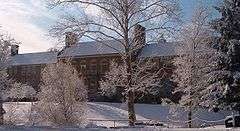Fairmont Senior High School
| Fairmont Senior High School | |
|---|---|
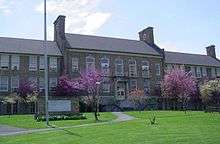 Main building | |
| Address | |
|
1 Loop Park Drive Fairmont, WV, (Marion County) 26554 United States | |
| Coordinates | 39°28′42″N 80°9′27″W / 39.47833°N 80.15750°WCoordinates: 39°28′42″N 80°9′27″W / 39.47833°N 80.15750°W |
| Information | |
| School type | Public Coeducational |
| Established | 1876 |
| School board | Marion County |
| School district | Marion County |
| Superintendent | Gary Price |
| Principal | Karen Finamore |
| Grades | 9-12 |
| Age | 14 to 19 |
| Enrollment | 734[1] |
| Average class size | 30 |
| Campus size | 15.0 acres (61,000 m2)[2] |
| Campus type | Closed |
| Color(s) | Royal blue, white & red (secondary) |
| Slogan | "Polar Bear Pride" |
| Athletics conference | Big Ten |
| Mascot | Polar bear |
| Nickname | Loop Park Loonies |
| Rival | East Fairmont High School |
| Newspaper | Hi Life |
| Yearbook | Maple Leaves |
| Feeder schools |
West Fairmont Middle School, Rivesville Middle School, Barrackville Middle School, Fairmont Catholic Grade School |
| Main Office | (304)-367-2150 |
| Social Media |
twitter |
| Website |
www |
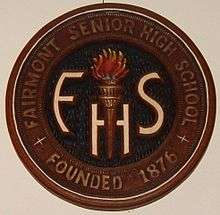 | |
Fairmont Senior High School (FSHS) is a historic secondary school located in Fairmont, West Virginia, and is listed on the National Register of Historic Places. The school serves grades nine through twelve and is part of the Marion County School District. The athletic teams are referred to as the Polar Bears, giving rise to the term "Polar Bear Pride".
History
Established in 1876, the school was relocated once in 1905 and again in 1928 to accommodate the growing student population. The first building to house Fairmont High School was the Second Ward Building on the corner of Adams and Quincy. Between 1872, when the building was constructed, and 1892 the building jointly held the public and normal schools of Fairmont despite the public school and normal department's separation in 1875. Fairmont High School was founded in the Second Ward Building in 1876, and the first graduating class consisted of four students in 1877. Increased enrollment and the need for additional facilities eventually lead to the construction of a new school.
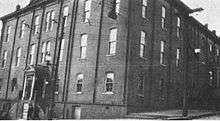
In 1905 a new building was constructed at "The Point", consisting of 12 classrooms, labs, offices and a library with the top floor used as a gymnasium. The first class attended the new Fairmont High School in 1906. A gymnasium was constructed at the rear of the building in 1922, and although the high school no longer stands, the Fifth Street Gym is still in operation for interscholastic purposes. In 1927 the school system decided to adopt a 6-3-3 organization for schools in the area. This meant that grades 7-9 would make up a junior high school, while grades 10-12 would create a senior high school. To achieve this, a new senior high school was needed. The building that was constructed at Loop Park in 1928 established Fairmont Senior High School where it still resides. The old building remained in operation as Fairmont Junior High School until 1963 when the foundation of the building slipped, forcing its closure. A building was constructed at Fairmont Senior High School to hold the displaced ninth grade students, while the seventh and eighth grades were relocated to a new school on High Street. Much of the new building was constructed of concrete, which helped to mitigate the destruction caused by a fire that damaged a large section of the school's roof on February 16, 1979. The historic foundation of the building was preserved.[3]
The campus has since become a conglomeration of facilities displaying the differences in architectural influences for over a century. At 15.0 acres (61,000 m2), the campus on Oakwood Road ranks among the most beautiful in the state and country. The outdoor living classroom of trees with historical significance also cultivates flowering dogwoods, maples, and oaks, which enhance the landscape and make every season a beautiful environment for learning.
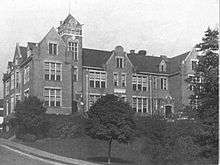
The campus currently consists of the original school and several separate structures including a science and mathematics building called the Freshman building, a full-sized gymnasium, and a cafeteria. The decentralized campus provides for a college atmosphere due to the outdoor nature of travel between classes. The campus also features many walkways, a small waterfall, flowering bushes, and rolling hills.
National Register
|
Fairmont Senior High School | |
|
Main Building | |
  | |
| Location | 1 Loop Park, Fairmont, West Virginia |
|---|---|
| Coordinates | 39°28′42″N 80°9′27″W / 39.47833°N 80.15750°W |
| Built | April 1, 1929 |
| Architect | William B. Ittner |
| Architectural style | Colonial Revival |
| NRHP Reference # | 02000254[4] |
| Added to NRHP | March 22, 2002 |
On March 22, 2002 Fairmont Senior High School was listed on the National Register of Historic Places.[4] Architect William B. Ittner, who is responsible for over three dozen entries in the National Register, designed the school in the late 1920s. He was prominent in St. Louis, Missouri where his firm Ittner Architects still operates.[5]
The school's architectural classification is Colonial Revival, with a stone foundation, brick walls, and asphalt shingle roofing. Materials were provided by the local Smallwood Low Stone Company. Excavation began on January 26, 1928, by the builders D. J. Phipps of Roanoke, Virginia, and the building was finished just over a year later on April 1, 1929, with a total cost of approximately $574,000.[6] The main building originally possessed 33 classrooms, and could comfortably accommodate 900 students. Plans were included to expand the building should the student population increase.
Fairmont Senior possesses many unique features that fortify its historic nature. The open light court or "senior court" is bound on all sides by interior walls of the school, but is not constrained by a ceiling. The opening provides sunlight to the surrounding halls and classrooms, as well as the small glass greenhouse located just inside the court. In 1929, the first class to graduate from the building presented the school with a statue of Abraham Lincoln that still stands outside of senior court.

The school also possessed a central ventilation system that provided fresh air to the classrooms and featured two chimneys that can still be seen from the exterior of the building. This system was later closed off due to fire codes. Another notable contribution are the eight tiled water fountain backsplashes. Each displays a different scene and contains the original tiles used in its creation.
The auditorium originally housed 1107 opera style chairs and a 16 by 50-foot (15 m) wooden stage. Later, when the stage was expanded, the first four rows of seating were removed leaving 976 seats. By the start of the 20th century, many of the seats were in poor condition and needed to be replaced. To preserve the historic nature of one of the school's greatest attributes, the 1000 Voices fund was established to restore the auditorium to its original state. In 2001 the seats were dismantled and sent away to be completely refurbished and reinstalled into the auditorium. Intricate details such as the gold leaf ribbons on the house lighting globes was also preserved, as well as detailed paintings on the proscenium arch.
Other structures also contribute to the school's historic nature. A small single arch concrete bridge crosses a stream that divides the campus; a stone wall approximately 100 feet (30 m) in length runs along the back of the school; and two brick gate posts stand at the entrance of the campus.
Inscriptions
Adding to the historical significance of the building are several inscriptions that can be found etched into the stone at various locations on the exterior of the main building. The inscription at the main entrance was taken from a quote by Daniel Webster who spoke at the dedication of the Bunker Hill Monument in 1825.
| Main entrance | Auditorium wing | Gymnasium wing |
|---|---|---|
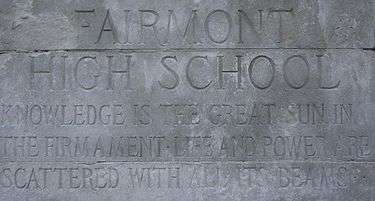
FAIRMONT HIGH SCHOOL KNOWLEDGE IS THE GREAT SUN IN THE FIRMAMENT – LIFE AND POWER ARE SCATTERED WITH ALL ITS BEAMS |
 AND THERE WAS LIGHT" |
AND THE WORLD WILL BE SAFE |
| First rear entrance | Second rear entrance | |
 LIVE IN DEEDS - NOT WORDS |
 ACT IN THE LIVING PRESENT | |
Fine arts
| Fight song |
|
Fight for ol’ Fairmont Fairmont must win. Fight to the finish Never give in. Rah Rah Rah You do your best, boys We’ll do the rest, boys Fight for ol’ FSH! |
Band
The Polar Bear Marching band is under the direction of Mr. John Schneider and regularly travels to participate in competitive events. The band has performed in Macy's Thanksgiving Day Parade in New York City, Walt Disney World, and Universal Studios.[7] The curriculum includes Percussion Ensemble, Jazz Ensemble, Marching and Concert Bands. Fairmont Senior is also one of the few schools in the state to have a full steel drum band perform at various state venues. The band also won the TOB group 4 division in 2007.
| Alma Mater |
|
O’er the green campus of Fairmont High, Rings out the strong spirit of do or die. Our sons give their pledges, loyal and true. Dear Alma Mater, we sing to you! |
Choral music
Fairmont Senior High School has a rich tradition of providing some of the highest quality choral music at the high school level. The Fairmont Senior Madrigal Chamber Choir, a renaissance style a cappella choir, has won numerous all-around festivals of music choral competitions in places such as Montreal, New York City, and Williamsburg. The choral department includes the Choraliers, Madrigals, Freshman, Men's and Women's Chorus, and piano instruction. The elite Madrigals, an Elizabethan style choral group, entertain in authentic costumes. The group has won competitive prestigious prizes and performed at the inauguration of West Virginia Governor Joe Manchin.
Drama and speech
The International Thespian Society originated in Fairmont, West Virginia and was founded by Dr. Paul Opp and Mr. Harry Leeper. Two of the three original chapters were Fairmont Senior High School Troupe #2 and East Fairmont High School Troupe #3.
Averaging 50 trophies for the past 25 years, the speech team's total trophy accumulation numbers over 1200. FSHS has placed more students in the top 48 at the Octo Finals than any high school in the state of West Virginia.
Athletics
The boys' sports teams are referred to as the Polar Bears and the girls' teams, the Lady Polar Bears. Fairmont Senior competes in the North Central Athletic Conference (NCAC) and regularly contends for state titles in various sports. The school has 21 sports teams and is one of the few in the state to have a lacrosse team. The school has also won 36 state titles and has many honorable mentions as the runners up in state championship events.
| Fairmont Senior West Virginia State Championship History[8][9] | |||
|---|---|---|---|
| Boys' sports | State titles | Girls' sports | State titles |
| Baseball | Softball | ||
| Basketball | 1927, 1939, 1942, 1949, 1996, 2016 | Basketball | 1997 |
| Cross country | 1977, 1988, 1997, 1999, 2012 | Cross country | 1989, 1996, 1997, 1998, 2003 |
| Golf | Cheerleading | 1991, 1992, 1999 | |
| Football | 1946 | Volleyball | |
| Soccer | 2015 | Soccer | |
| Swimming | 1999, 2000, 2001, 2002, 2003, 2004, 2005, 2006, 2007, 2008 | Swimming | 2006 |
| Tennis | Tennis | ||
| Track & field | Track & field | 1999 | |
| Lacrosse† | 2009 | Lacrosse† | 2008, 2009, 2010, 2011, 2016 |
| Wrestling | 1960 | ||
| Boys' total | 22 | Girls' total | 16 |
| †Lacrosse is yet to be a sanctioned sport | |||
Mascot
Originally the athletics teams were known as "Ice's Men" in reference to Coach Frank Ice who coached the school's athletic teams from 1914 to 1920. In 1926 the Polar Bear mascot was officially established in honor of the coach. The class of 1972 donated twin polar bear statues that line the entrance of the school.
Rivalry
Fairmont Senior is one of three AA high schools in Marion County, along with East Fairmont High School and North Marion High School. While both schools have presented competition for FSHS, the intense rivalry that exists between Fairmont Senior and East Fairmont has been considered one of the greatest in the state, known simply as the East-West Rivalry.
The two schools have met for 93 consecutive years beginning on October 25, 1921, making the series one of the oldest in the state. Considered to be at the peak of its intensity during the 1940s and 1950s, the event was then recognized as a state-wide festivity and drew large crowds annually.[10] Adding to the tension between the two schools is the fact that they share a home football field at the historic East-West Stadium. For the East-West football game the home team is alternated each year and decorates the stadium in their school's colors.
Fairmont Senior leads the series 59-28-7. Three scoreless ties and 27 shutouts have been recorded throughout the rivalry's history.[11]
East-West Stadium
The Polar Bear football, soccer, lacrosse, and track teams all practice and perform off-campus at the historic East-West Stadium. The stadium was built in the 1920s and is home to both Fairmont Senior High School and East Fairmont High School. The facility includes a football/soccer/lacrosse field, track, and a swimming pool. The stadium, which covers one full city block, has an approximate capacity of six-thousand spectators.[12]
Swimming
Until the 2009 season, the boy's Polar Bear swim team had never lost the West Virginia state championship title, winning every state swim meet since the formation of the sport in 1999.[13] This accomplishment puts Fairmont Senior in the company of Parkersburg High School as the only two AAA high schools in the state of West Virginia to achieve a streak of ten or more state championship victories in a single sport.
Notable alumni

- Mary Lou Retton, American all-around gold-winning Olympic gymnast.†
- Jim Delligatti, Inventor of the Big Mac[14]
- Jazz Securo (Chip Gerdes), international ring announcer
- Michael Garrison, former president of West Virginia University.
- Frank Kendall Everest, Jr., once "the fastest man alive"
†Attended freshman year before training for the Olympics.
- Rashod Kent, NFL player
See also
References
- ↑ Marion County Schools Enrollment Data
- ↑ 1930 Maple Leaves
- ↑ FSHS Foundation History: Fire
- 1 2 National Park Service (2008-04-15). "National Register Information System". National Register of Historic Places. National Park Service.
- ↑ Ittner Architects
- ↑ Original Dedication
- ↑ Polar Bear Band
- ↑ WVSSAC
- ↑ WV Lacrosse
- ↑ East-West History
- ↑ "East-West History". Times West Virginian. Fairmont, WV. 6 November 2009. p. 4B.
- ↑ East-West Stadium
- ↑ WVSSAC
- ↑ McDonald's Media Documents
External links
| Wikimedia Commons has media related to Fairmont Senior High School. |
